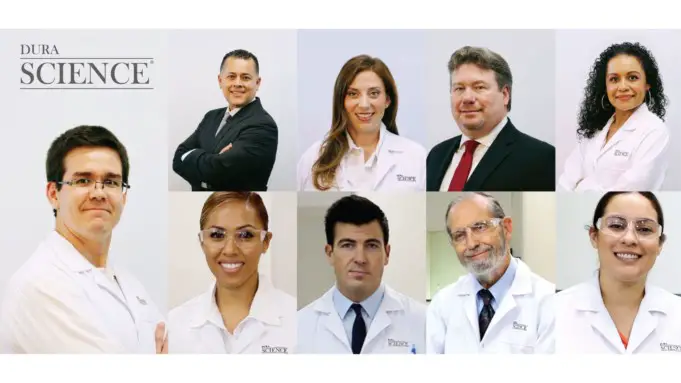Skin is the body’s largest organ and the only one that’s visible to the naked eye. Most people may not consciously notice it unless it’s in particularly poor or pristine condition, but it has a considerable impact on their perceptions of health and beauty.
While an eternal “fountain of youth” has yet to be discovered, groundbreaking research by DuraScience and others suggests that there are natural ways to prevent and reduce blemishes, dark spots, wrinkles, and other visible signs of aging.
The team of world renowned experts at DuraScience. (PRNewsfoto/DuraScience Institute of USA)According to DuraScience, healthy skin is a combination of genetics, nutrition, microbiota, and anti-inflammation. All of the body’s cells – including the skin cells – are composed of protein, a substance produced and regulated by 20,000–25,000 genes, which determine whether an individual’s skin is dry or oily.
The protein and pigment melanin determines skin tone and appearance. Normal skin cells are surrounded by an extracellular matrix (ECM) – a gel-like substance that consists of water, polysaccharides, collagen proteins, and hyaluronic acid. The ECM enables the skin to rejuvenate, a process that occurs roughly every three weeks for the average adult.
A healthy diet with a sufficient amount of Zinc, Magnesium, and Vitamin C is essential for infusing the cellular fibroblast with optimum levels of collagen. The digestive system or gut contains over 1,000 bacterial species, primarily Firmicutes and Bacteroidetes, which help regulate weight loss and weight gain. Normal types and quantities of microbiota are responsible for healthy bones, hormones, metabolism, and skin.
Conversely, imbalanced microbiota or dysbiosis and small intestinal bacterial overgrowth (SIBO) often lead to intestinal inflammation, acne, eczema or atopic dermatitis, rashes, and other skin conditions. Antioxidants act as anti-inflammatory, antiaging agents, protecting the skin from the effects of free radicals and other toxic pollutants.
Ongoing research aims to target skin defects at the genetic level. Meanwhile, studies support the idea that rectifying the imbalance of gut microbiota can alter the genes’ expression and improve the skin’s quality. One way to do this is to take prebiotics and probiotics to encourage the glucose-insulin homeostasis necessary for a healthy liver and muscles.
A regular intake of nutrients such as Zinc, Magnesium, Vitamin C, Hyaluronic Acid, deep-sea fish, and soybeans can all contribute to the amount of collagen necessary for healthy skin. Other beneficial substances are antioxidants, which come in two varieties: enzymatic and nonenzymatic.
The former includes the catalase, glutathione, and superoxide dismutases systems; the latter is composed of ascorbic acid (Vitamin C), carotenoids, flavonoids, glutathione, melatonin, tocopherols, tocotrienols (Vitamin E), and uric acid.
Antioxidant-rich foods and vitamins include grape seeds, green tea, niacinamide (Vitamin B3), and resveratrol. Antioxidants are important for reducing free radicals in the body, leading to healthier skin, cells, and DNA. These methods are known to have a positive impact on skin cells and their protective ECMs.
DuraScience’s goal is to use healthy, natural means to target specific skin concerns at the cellular and genetic levels. These methods will transform the body’s largest, most visible organ from the inside out, helping to reduce – and ultimately prevent – skin conditions as minor as common pimples or as serious as eczema.
Best of all, targeting and eliminating these skin issues at their source could provide an effective, long-lasting cure and render regular, expensive visits to a dermatologist unnecessary. By providing a cure rather than an ongoing medication, DuraScience seeks to place itself at the forefront of better, more natural health services.












